RD Sharma Solutions for Class 8 Chapter 25 Data Handling - III (Pictorial Representation of Data as Pie Charts or Circle Graphs) Free Online
EXERCISE 25.1 PAGE NO: 25.12
1. The number of hours, spent by a school boy on different activities in a working day, is given below:
| Activities | Sleep | School | Home | Play | Others | Total |
| Number of Hours | 8 | 7 | 4 | 2 | 3 | 24 |
Present the information in the form of a pie-chart.
Solution:
Here, total number of hours = 24
So,
The central angle = (component value/24) × 360°
The central angle for each activity will be calculated as follows
| Activity | Number of Hours | Central Angle |
| Sleep | 8 | 8/24 × 360° = 120o |
| School | 7 | 7/24 × 360° = 105o |
| Home | 4 | 4/24 × 360° = 60o |
| Play | 2 | 2/24 × 360° = 30o |
| Others | 3 | 3/24 × 360° = 45o |
Now, the pie-chart can be constructed by using the given data.
Steps to construct:
Step 1: Draw the circle of an appropriate radius.
Step 2: Draw a vertical radius anywhere inside the circle.
Step 3: Choose the largest central angle. Here, it is 120o. Construct a sector of central angle 120o whose one radius coincides with the radius drawn in step 2 and the other radius is in clockwise direction to the vertical radius.
Step 4: Construct other sectors representing other values in clockwise direction in descending order of magnitudes of their central angles.
Step 5: Shade the sectors so obtained by different colours and label them as shown in below figure.

2. Employees of a company have been categorized according to their religions as given below:
| Religious | Hindu | Muslim | Sikh | Christian | Total |
| Number of Workers | 420 | 300 | 225 | 105 | 1080 |
Draw a pie-chart to represent the above information.
Solution:
Here, total number of workers = 1080
So,
The central angle = (component value/1080) × 360°
The central angle for each activity will be calculated as follows
| Religious | Number of Workers | Central Angle |
| Hindu | 420 | 420/1080 × 360° = 144 |
| Muslim | 300 | 300/1080 × 360° = 102.9 |
| Sikh | 225 | 225/1080 × 360° = 77.14 |
| Christian | 105 | 105/1080 × 360° = 36 |
Now, the pie-chart can be constructed by using the given data.
Steps to construct:
Step 1: Draw the circle of an appropriate radius.
Step 2: Draw a vertical radius anywhere inside the circle.
Step 3: Choose the largest central angle. Construct a sector of central angle, whose one radius coincides with the radius drawn in step 2 and the other radius is in clockwise direction to the vertical radius.
Step 4: Construct other sectors representing other values in clockwise direction in descending order of magnitudes of their central angles.
Step 5: Shade the sectors so obtained by different colours and label them as shown in below figure.
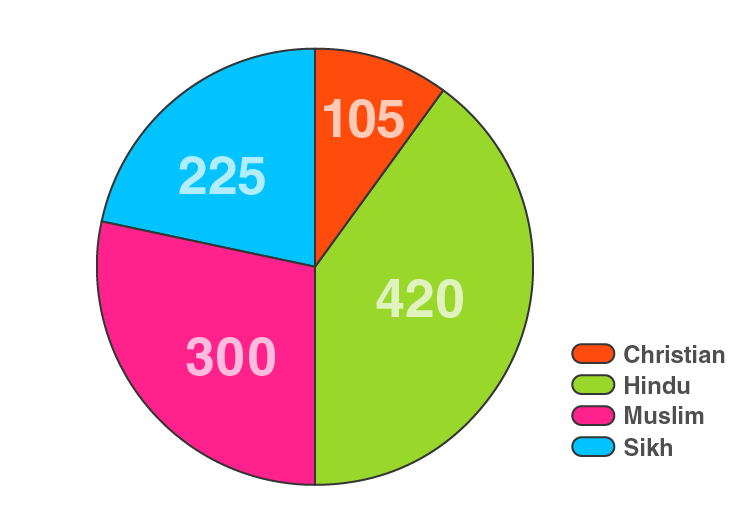
3. In one day the sales (in rupees) of different items of a baker’s shop are given below:
| Items | Ordinary bread | Fruit bread | Cakes and Pastries | Biscuits | Others | Total |
| Sales (in Rs) | 260 | 40 | 100 | 60 | 20 | 780 |
Draw a pie-chart to represent the above information.
Solution:
Here, total sales = 780
So,
The central angle = (component value/780) × 360°
The central angle for each activity will be calculated as follows
| Items | Sales (in Rs) | Central Angle |
| Ordinary bread | 260 | 260/780 × 360° = 195 |
| Fruit bread | 40 | 40/780 × 360° = 30 |
| Cakes and Pastries | 100 | 100/780 × 360° = 75 |
| Biscuits | 60 | 60/780 × 360° = 45 |
| Others | 20 | 20/780 × 360° = 15 |
Now, the pie-chart can be constructed by using the given data.
Steps to construct:
Step 1: Draw the circle of an appropriate radius.
Step 2: Draw a vertical radius anywhere inside the circle.
Step 3: Choose the largest central angle. Construct a sector of central angle, whose one radius coincides with the radius drawn in step 2 and the other radius is in clockwise direction to the vertical radius.
Step 4: Construct other sectors representing other values in clockwise direction in descending order of magnitudes of their central angles.
Step 5: Shade the sectors so obtained by different colours and label them as shown in below figure.
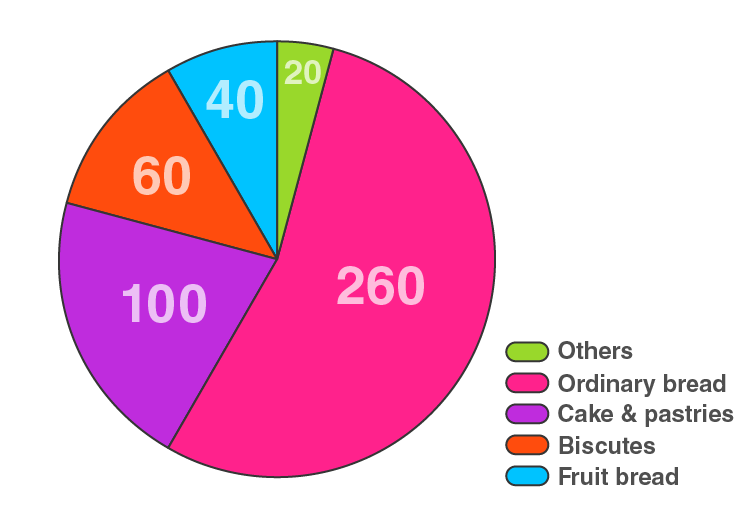
4. The following data shows the expenditure of a person on different items during a month. Represent the data by a pie-chart.
| Items of expenditure | Rent | Education | Food | Clothing | Others |
| Amount (in Rs) | 2700 | 1800 | 2400 | 1500 | 2400 |
Solution:
Here, total amount = Rs 10800
So,
The central angle = (component value/10800) × 360°
The central angle for each activity will be calculated as follows
| Items of expenditure | Amount (in Rs) | Central angle |
| Rent | 2700 | 2700/10800 × 360° = 90 |
| Education | 1800 | 1800/10800 × 360° = 60 |
| Food | 2400 | 2400/10800 × 360° = 80 |
| Clothing | 1500 | 1500/10800 × 360° = 50 |
| Others | 2400 | 2400/10800 × 360° = 80 |
Now, the pie-chart can be constructed by using the given data.
Steps to construct:
Step 1: Draw the circle of an appropriate radius.
Step 2: Draw a vertical radius anywhere inside the circle.
Step 3: Choose the largest central angle. Construct a sector of central angle, whose one radius coincides with the radius drawn in step 2 and the other radius is in clockwise direction to the vertical radius.
Step 4: Construct other sectors representing other values in clockwise direction in descending order of magnitudes of their central angles.
Step 5: Shade the sectors so obtained by different colours and label them as shown in below figure.
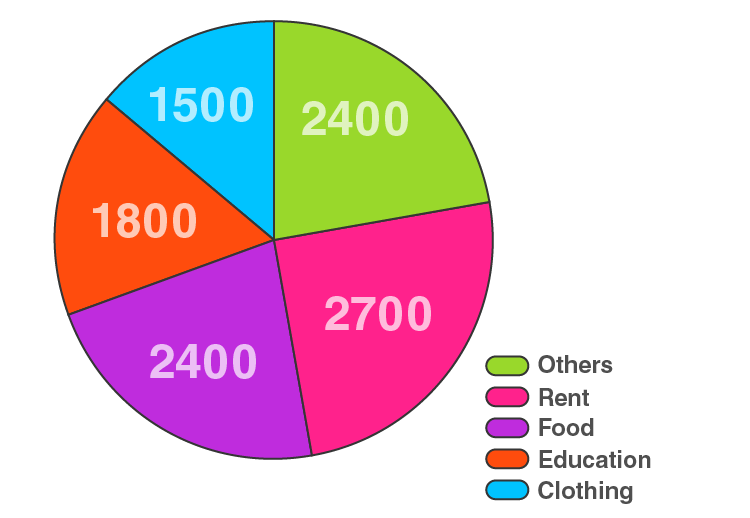
5. The percentages of various categories of workers in a state are given in the following table.
| Categories | Cultivators | Agricultural Labourers | Industrial Workers | Commercial Workers | Others |
| % of workers | 40 | 25 | 12.5 | 10 | 12.5 |
Present the information in the form of a pie-chart.
Solution:
Here, total % of workers = 100%
So,
The central angle = (component value/100) × 360°
The central angle for each activity will be calculated as follows
| Categories | % of workers | Central angle |
| Cultivators | 40 | 400/100 × 360° = 144 |
| Agricultural Labourers | 25 | 25/100 × 360° = 90 |
| Industrial Workers | 12.5 | 12.5/100 × 360° = 45 |
| Commercial Workers | 10 | 10/100 × 360° = 36 |
| Others | 12.5 | 12.5/100 × 360° = 45 |
Now, the pie-chart can be constructed by using the given data.
Steps to construct:
Step 1: Draw the circle of an appropriate radius.
Step 2: Draw a vertical radius anywhere inside the circle.
Step 3: Choose the largest central angle. Construct a sector of central angle, whose one radius coincides with the radius drawn in step 2 and the other radius is in clockwise direction to the vertical radius.
Step 4: Construct other sectors representing other values in clockwise direction in descending order of magnitudes of their central angles.
Step 5: Shade the sectors so obtained by different colours and label them as shown in below figure.

6. The following table shows the expenditure incurred by a publisher in publishing a book:
| Items | Papers | Printing | Binding | Advertising | Miscellaneous |
| Expenditure (in %) | 35% | 20% | 10% | 5% | 30% |
Present the above data in the form of pie-chart.
Solution:
Here, total Expenditure (in %) = 100%
So,
The central angle = (component value/100) × 360°
The central angle for each activity will be calculated as follows
| Items | Expenditure (in %) | Central angle |
| Papers | 35% | 35/100 × 360° = 126 |
| Printing | 20% | 20/100 × 360° = 72 |
| Binding | 10% | 10/100 × 360° = 36 |
| Advertising | 5% | 5/100 × 360° = 18 |
| Miscellaneous | 30% | 30/100 × 360° = 108 |
Now, the pie-chart can be constructed by using the given data.
Steps to construct:
Step 1: Draw the circle of an appropriate radius.
Step 2: Draw a vertical radius anywhere inside the circle.
Step 3: Choose the largest central angle. Construct a sector of central angle, whose one radius coincides with the radius drawn in step 2 and the other radius is in clockwise direction to the vertical radius.
Step 4: Construct other sectors representing other values in clockwise direction in descending order of magnitudes of their central angles.
Step 5: Shade the sectors so obtained by different colours and label them as shown in below figure.
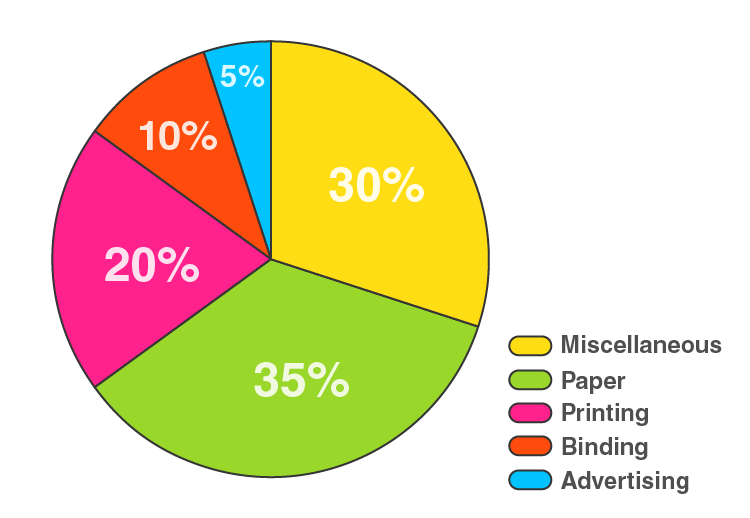
7. Percentage of the different products of a village in a particular district are given below. Draw a pie chart representing this information.
| Items | Wheat | Pulses | Jwar | Groundnuts | Vegetables | Total |
| % | 125/3 | 125/6 | 25/2 | 50/3 | 25/3 | 100 |
Solution:
Here, total % = 100%
So,
The central angle = (component value/100) × 360°
The central angle for each activity will be calculated as follows
| Items | % | Central angle |
| Wheat | 125/3 | (125/3)/100 × 360° = 150 |
| Pulses | 125/6 | (125/6)/100 × 360° = 75 |
| Jwar | 25/2 | (25/2)/100 × 360° = 45 |
| Groundnuts | 50/3 | (50/3)/100 × 360° = 60 |
| Vegetables | 25/3 | (25/3)/100 × 360° = 30 |
Now, the pie-chart can be constructed by using the given data.
Steps to construct:
Step 1: Draw the circle of an appropriate radius.
Step 2: Draw a vertical radius anywhere inside the circle.
Step 3: Choose the largest central angle. Construct a sector of central angle, whose one radius coincides with the radius drawn in step 2 and the other radius is in clockwise direction to the vertical radius.
Step 4: Construct other sectors representing other values in clockwise direction in descending order of magnitudes of their central angles.
Step 5: Shade the sectors so obtained by different colours and label them as shown in below figure.

8. Draw a pie diagram for the following data of expenditure pattern in a family:
| Items | Food | Clothing | Rent | Education | Unforeseen events | Medicine |
| Expenditure (in %) | 40% | 20% | 10% | 10% | 15% | 5% |
Solution:
Here, total % = 100%
So,
The central angle = (component value/100) × 360°
The central angle for each activity will be calculated as follows
| Items | Expenditure (in %) | Central angle |
| Food | 40% | 40/100 × 360° = 144 |
| Clothing | 20% | 20/100 × 360° = 72 |
| Rent | 10% | 10/100 × 360° = 36 |
| Education | 10% | 10/100 × 360° = 36 |
| Unforeseen events | 15% | 15/100 × 360° = 54 |
| Medicines | 5% | 5/100 × 360° = 18 |
Now, the pie-chart can be constructed by using the given data.
Steps to construct:
Step 1: Draw the circle of an appropriate radius.
Step 2: Draw a vertical radius anywhere inside the circle.
Step 3: Choose the largest central angle. Construct a sector of central angle, whose one radius coincides with the radius drawn in step 2 and the other radius is in clockwise direction to the vertical radius.
Step 4: Construct other sectors representing other values in clockwise direction in descending order of magnitudes of their central angles.
Step 5: Shade the sectors so obtained by different colours and label them as shown in below figure.
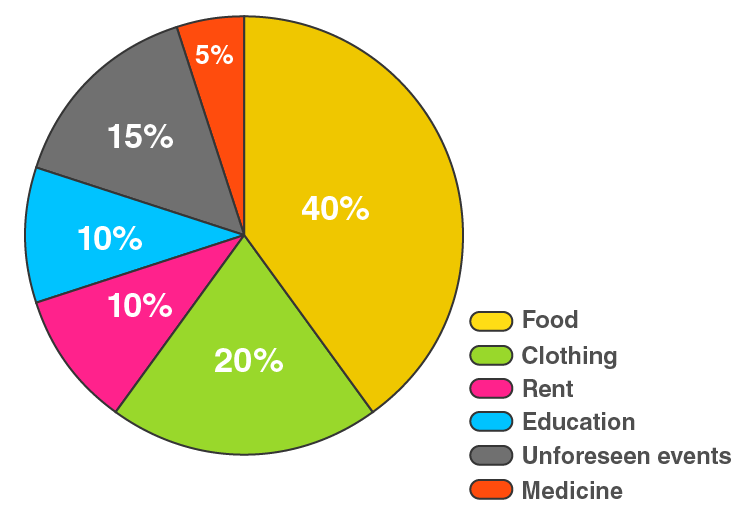
9. Draw a pie diagram of the areas of continents of the world given in the following table:
| Continents | Asia | U.S.S.R | Africa | Europe | North America | South America | Australia |
| Area (in million sq.km) | 26.9 | 20.5 | 30.3 | 4.9 | 24.3 | 17.9 | 8.5 |
Solution:
Here, total Area = 133.3 million sq.km
So,
The central angle = (component value/133.3) × 360°
The central angle for each activity will be calculated as follows
| Continents | Area (in million sq.km) | Central angle |
| Asia | 26.9 | 26.9/133.3 × 360° = 72.6 |
| U.S.S.R | 20.5 | 20.5/133.3 × 360° = 55.4 |
| Africa | 30.3 | 30.3/133.3 × 360° = 81.8 |
| Europe | 4.9 | 4.9/133.3 × 360° = 13.2 |
| North America | 24.3 | 24.3/133.3 × 360° = 65.6 |
| South America | 17.9 | 17.9/133.3 × 360° = 48.3 |
| Australia | 8.5 | 8.5/133.3 × 360° = 23 |
Now, the pie-chart can be constructed by using the given data.
Steps to construct:
Step 1: Draw the circle of an appropriate radius.
Step 2: Draw a vertical radius anywhere inside the circle.
Step 3: Choose the largest central angle. Construct a sector of central angle, whose one radius coincides with the radius drawn in step 2 and the other radius is in clockwise direction to the vertical radius.
Step 4: Construct other sectors representing other values in clockwise direction in descending order of magnitudes of their central angles.
Step 5: Shade the sectors so obtained by different colours and label them as shown in below figure.
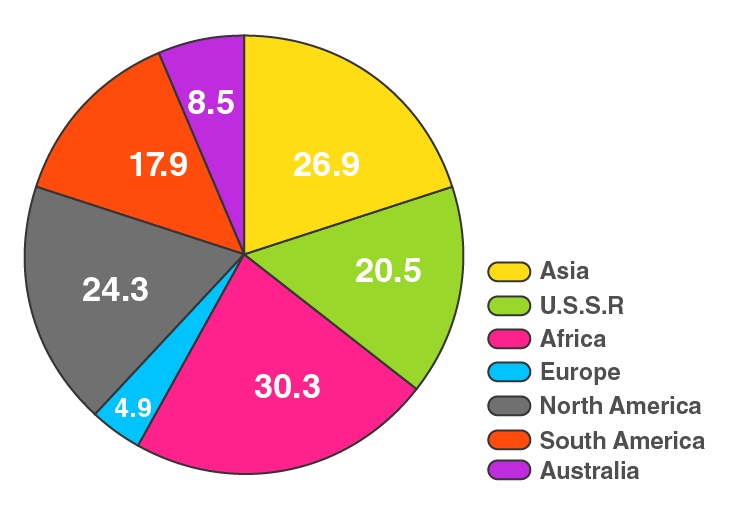
10. The following data gives the amount spent on the construction of a house. Draw a pie diagram.
| Items | Cement | Timber | Bricks | Labour | steel | Miscellaneous |
| Expenditure (in thousand Rs) | 60 | 30 | 45 | 75 | 45 | 45 |
Solution:
Here, total Expenditure = 300 thousand rupees
So,
The central angle = (component value/300) × 360°
The central angle for each activity will be calculated as follows
| Items | Expenditure (in thousand Rs) | Central angle |
| Cement | 60 | 60/300 × 360° = 72 |
| Timber | 30 | 30/300 × 360° = 36 |
| Bricks | 45 | 45/300 × 360° = 54 |
| Labour | 75 | 75/300 × 360° = 90 |
| Steel | 45 | 45/300 × 360° = 54 |
| Miscellaneous | 45 | 45/300 × 360° = 54 |
Now, the pie-chart can be constructed by using the given data.
Steps to construct:
Step 1: Draw the circle of an appropriate radius.
Step 2: Draw a vertical radius anywhere inside the circle.
Step 3: Choose the largest central angle. Construct a sector of central angle, whose one radius coincides with the radius drawn in step 2 and the other radius is in clockwise direction to the vertical radius.
Step 4: Construct other sectors representing other values in clockwise direction in descending order of magnitudes of their central angles.
Step 5: Shade the sectors so obtained by different colours and label them as shown in below figure.

11. The following table shows how a student spends his pocket money during the course of a month. Represent it by a pie diagram.
| Items | Food | Entertainment | Other Expenditure | Savings |
| Expenditure | 40% | 25% | 20% | 15% |
Solution:
Here, total Expenditure = 100%
So,
The central angle = (component value/100) × 360°
The central angle for each activity will be calculated as follows
| Items | Expenditure | Central angle |
| Food | 40% | 40/100 × 360° = 144 |
| Entertainment | 25% | 25/100 × 360° = 90 |
| Other Expenditure | 20% | 20/100 × 360° = 72 |
| Savings | 15% | 15/100 × 360° = 54 |
Now, the pie-chart can be constructed by using the given data.
Steps to construct:
Step 1: Draw the circle of an appropriate radius.
Step 2: Draw a vertical radius anywhere inside the circle.
Step 3: Choose the largest central angle. Construct a sector of central angle, whose one radius coincides with the radius drawn in step 2 and the other radius is in clockwise direction to the vertical radius.
Step 4: Construct other sectors representing other values in clockwise direction in descending order of magnitudes of their central angles.
Step 5: Shade the sectors so obtained by different colours and label them as shown in below figure.
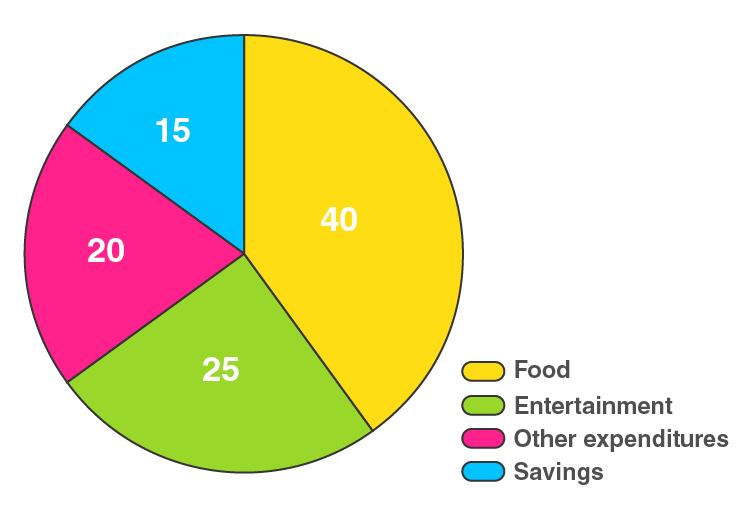
12. Represent the following data by a pie diagram:
| Items of expenditure | Expenditure |
| Family A Family B | |
| Food | 4000 6400 |
| Clothing | 2500 480 |
| Rent | 1500 3200 |
| Education | 400 1000 |
| Miscellaneous | 1600 600 |
| Total | 10000 16000 |
Solution:
Here, the total expenditure of family A = 10000 and family B = 11680
The central angle for family A = (component value/10000) × 360°
The central angle for family B = (component value/11680) × 360°
Hence, the central angle for each activity will be calculated as follows
| Items of expenditure | Expenditure of Family A | Expenditure of
Family B
| Central angle of Family A | Central angle of
Family B
|
| Food | 4000 | 6400 | 4000/10000 × 360° = 144 | 6400/11680 × 360° = 197.3 |
| Clothing | 2500 | 480 | 2500/10000 × 360° = 90 | 480/11680 × 360° = 14.8 |
| Rent | 1500 | 3200 | 1500/10000 × 360° = 54 | 3200/11680 × 360° = 98.6 |
| Education | 400 | 1000 | 400/10000 × 360° = 14.4 | 1000/11680 × 360° = 30.8 |
| Miscellaneous | 1600 | 600 | 1600/10000 × 360° = 57.6 | 600/11680 × 360° = 18.5 |
Now, the pie-chart for Family A and Family B can be constructed by using the given data.
Steps to construct:
Step 1: Draw the circle of an appropriate radius.
Step 2: Draw a vertical radius anywhere inside the circle.
Step 3: Choose the largest central angle. Construct a sector of central angle, whose one radius coincides with the radius drawn in step 2 and the other radius is in clockwise direction to the vertical radius.
Step 4: Construct other sectors representing other values in clockwise direction in descending order of magnitudes of their central angles.
Step 5: Shade the sectors so obtained by different colours and label them as shown in below figure.

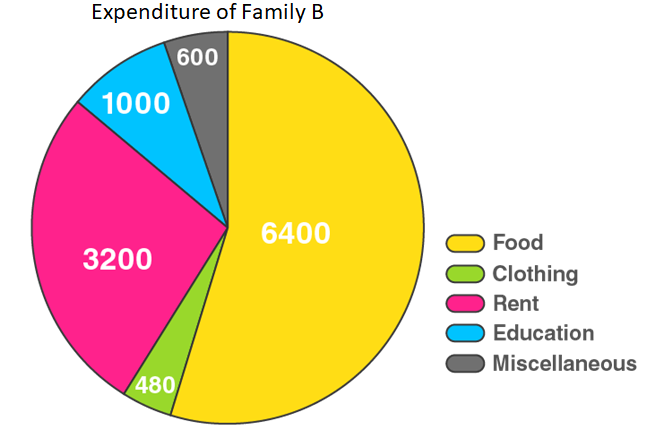
13. Following data gives the break up of the cost of production of a book:
| Printing | Paper | Binding charges | Advertisement | Royalty | Miscellaneous |
| 30% | 15% | 15% | 20% | 10% | 15% |
Draw a pie-diagram depicting the above information.
Solution:
Here, total cost of production of book = 105%
So,
The central angle = (component value/105) × 360°
The central angle for each activity will be calculated as follows
| Items | Expenditure | Central angle |
| Printing | 30% | 30/105 × 360° = 102.9 |
| Paper | 15% | 15/105 × 360° = 51.4 |
| Binding charges | 15% | 15/105 × 360° = 51.4 |
| Advertisement | 20% | 20/105 × 360° = 68.6 |
| Royalty | 10% | 10/105 × 360° = 34.3 |
| Miscellaneous | 15% | 15/105 × 360° = 51.4 |
Now, the pie-chart can be constructed by using the given data.
Steps to construct:
Step 1: Draw the circle of an appropriate radius.
Step 2: Draw a vertical radius anywhere inside the circle.
Step 3: Choose the largest central angle. Construct a sector of central angle, whose one radius coincides with the radius drawn in step 2 and the other radius is in clockwise direction to the vertical radius.
Step 4: Construct other sectors representing other values in clockwise direction in descending order of magnitudes of their central angles.
Step 5: Shade the sectors so obtained by different colours and label them as shown in below figure.
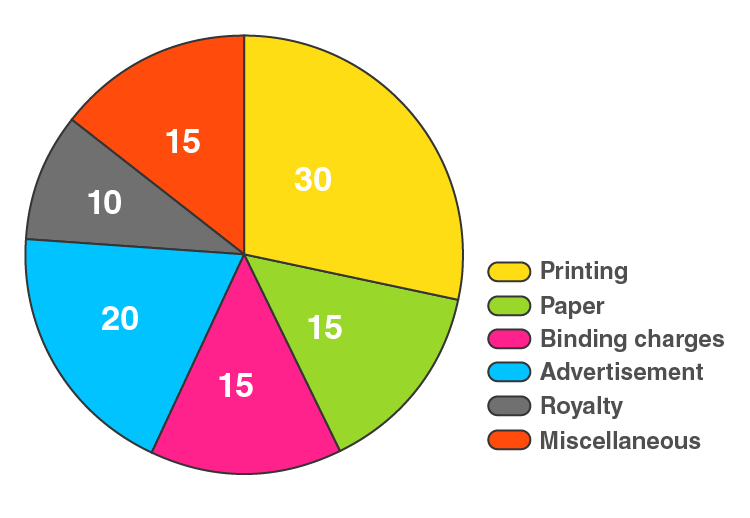
14. Represent the following data with the help of pie diagram:
| Items | Wheat | Rice | Tea |
| Production (in metric tons) | 3260 | 1840 | 900 |
Solution:
Here, total cost of production = 6000 metric tons
So,
The central angle = (component value/6000) × 360°
The central angle for each activity will be calculated as follows
| Items | Production | Central angle |
| Wheat | 3260 | 3260/6000 × 360° = 195.6 |
| Rice | 1840 | 1840/6000 × 360° = 110.4 |
| Tea | 900 | 900/6000 × 360° = 54 |
Now, the pie-chart can be constructed by using the given data.
Steps to construct:
Step 1: Draw the circle of an appropriate radius.
Step 2: Draw a vertical radius anywhere inside the circle.
Step 3: Choose the largest central angle. Construct a sector of central angle, whose one radius coincides with the radius drawn in step 2 and the other radius is in clockwise direction to the vertical radius.
Step 4: Construct other sectors representing other values in clockwise direction in descending order of magnitudes of their central angles.
Step 5: Shade the sectors so obtained by different colours and label them as shown in below figure.
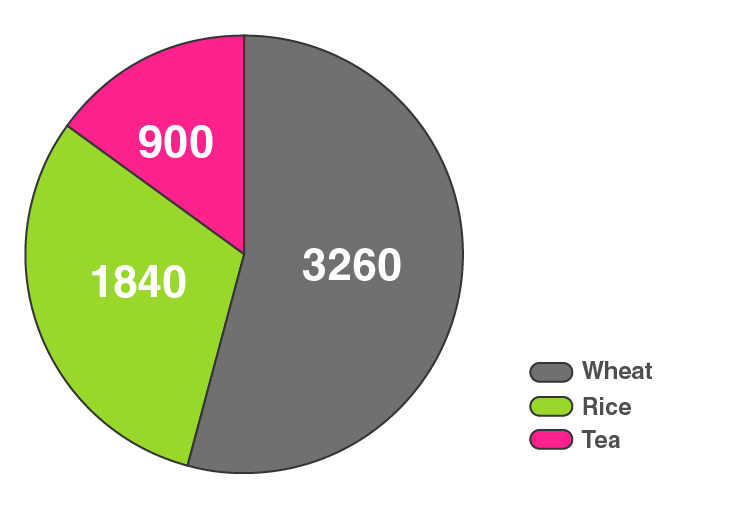
15. Draw a pie-diagram representing the relative frequencies (expressed as percentage) of the eight classes as given below:
12.6, 18.2, 17.5, 20.3, 2.8, 4.2, 9.8, 14.7
12.6, 18.2, 17.5, 20.3, 2.8, 4.2, 9.8, 14.7
Solution:
Here, total amount = 100.1%
So,
The central angle = (component value/100.1) × 360°
The central angle for each activity will be calculated as follows
| Class | Amount (in %) | Central angle |
| 1 | 12.6 | 12.6/100.1 × 360° = 45.3 |
| 2 | 18.2 | 18.2/100.1 × 360° = 65.5 |
| 3 | 17.5 | 17.5/100.1 × 360° = 62.9 |
| 4 | 20.3 | 20.3/100.1 × 360° = 73 |
| 5 | 2.8 | 2.8/100.1 × 360° = 10.1 |
| 6 | 4.2 | 4.2/100.1 × 360° = 15.1 |
| 7 | 9.8 | 9.8/100.1 × 360° = 35.2 |
| 8 | 14.7 | 14.7/100.1 × 360° = 52.9 |
Now, the pie-chart can be constructed by using the given data.
Steps to construct:
Step 1: Draw the circle of an appropriate radius.
Step 2: Draw a vertical radius anywhere inside the circle.
Step 3: Choose the largest central angle. Construct a sector of central angle, whose one radius coincides with the radius drawn in step 2 and the other radius is in clockwise direction to the vertical radius.
Step 4: Construct other sectors representing other values in clockwise direction in descending order of magnitudes of their central angles.
Step 5: Shade the sectors so obtained by different colours and label them as shown in below figure.
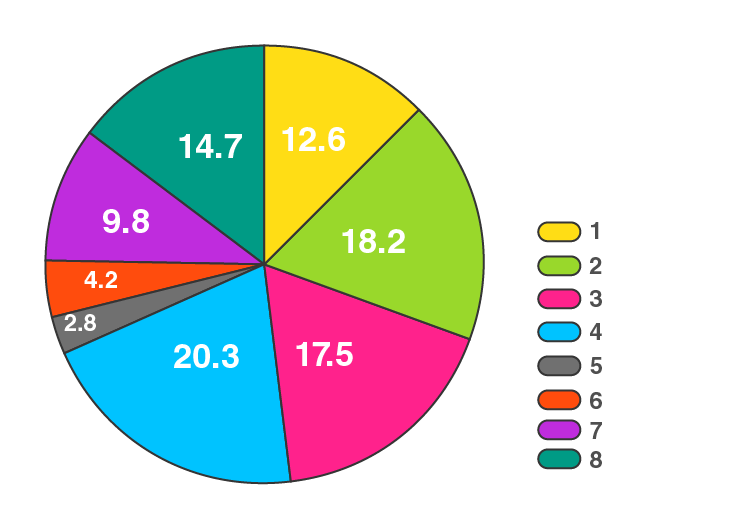
16. Following is the break up of the expenditure of a family on different items of consumption:
| Items | Food | Clothing | Rent | Education | Fuel etc. | Medicine | Miscellaneous |
| Expenditure (in Rs) | 1600 | 200 | 600 | 150 | 100 | 80 | 270 |
Draw a pie-diagram to represent the above data.
Solution:
Here, total expenditure = 3000 Rs
So,
The central angle = (component value/3000) × 360°
The central angle for each activity will be calculated as follows
| Items | Expenditure (in Rs) | Central angle |
| Food | 1600 | 1600/3000 × 360° = 192 |
| Clothing | 200 | 200/3000 × 360° = 24 |
| Rent | 600 | 600/3000 × 360° = 72 |
| Education | 150 | 150/3000 × 360° = 18 |
| Fuel | 100 | 100/3000 × 360° = 12 |
| Medicine | 80 | 80/3000 × 360° = 9.6 |
| Miscellaneous | 270 | 270/3000 × 360° = 32.4 |
Now, the pie-chart can be constructed by using the given data.
Steps to construct:
Step 1: Draw the circle of an appropriate radius.
Step 2: Draw a vertical radius anywhere inside the circle.
Step 3: Choose the largest central angle. Construct a sector of central angle, whose one radius coincides with the radius drawn in step 2 and the other radius is in clockwise direction to the vertical radius.
Step 4: Construct other sectors representing other values in clockwise direction in descending order of magnitudes of their central angles.
Step 5: Shade the sectors so obtained by different colours and label them as shown in below figure.
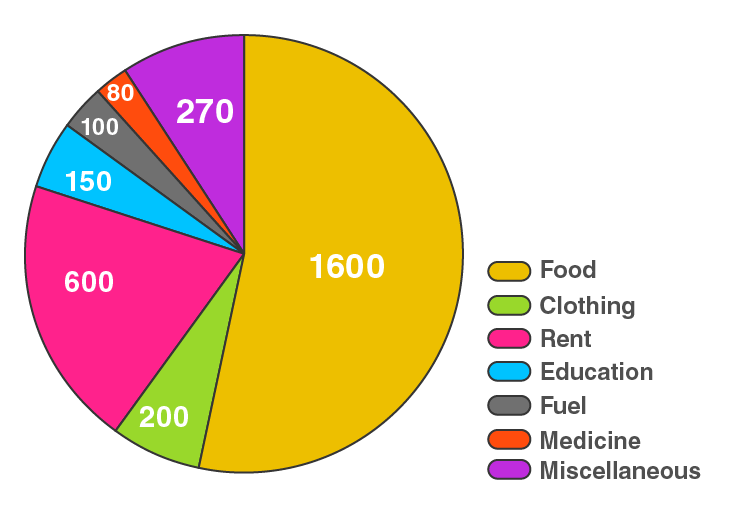
17. Draw a pie diagram for the following data of the investment pattern in a five years plan:
| Agriculture | Irrigation and Power | Small Industries | Transport | Social service | Miscellaneous |
| 14% | 16% | 29% | 17% | 16% | 8% |
Solution:
Here, total investment = 100%
So,
The central angle = (component value/100) × 360°
The central angle for each activity will be calculated as follows
| Data | Investment | Central angle |
| Agriculture | 14% | 14/100 × 360° = 50.4 |
| Irrigation and Power | 16% | 16/100 × 360° = 57.6 |
| Small Industries | 29% | 29/100 × 360° = 104.4 |
| Transport | 17% | 17/100 × 360° = 61.2 |
| Social service | 16% | 16/100 × 360° = 57.6 |
| Miscellaneous | 8% | 8/100 × 360° = 28.8 |
Now, the pie-chart can be constructed by using the given data.
Steps to construct:
Step 1: Draw the circle of an appropriate radius.
Step 2: Draw a vertical radius anywhere inside the circle.
Step 3: Choose the largest central angle. Construct a sector of central angle, whose one radius coincides with the radius drawn in step 2 and the other radius is in clockwise direction to the vertical radius.
Step 4: Construct other sectors representing other values in clockwise direction in descending order of magnitudes of their central angles.
Step 5: Shade the sectors so obtained by different colours and label them as shown in below figure.

EXERCISE 25.2 PAGE NO: 25.21
1. The pie chart given in Fig. 25.17 represents the expenditure on different items in constructing a flat in Delhi. If the expenditure incurred on cement is Rs. 112500, find the following:
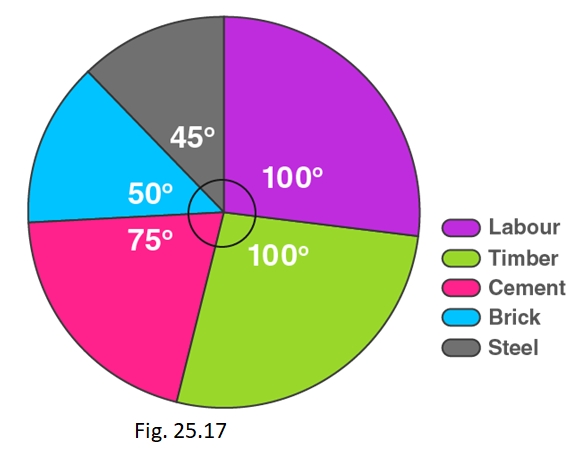
(i) Total cost of the flat.
(ii) Expenditure incurred on labour.
(ii) Expenditure incurred on labour.
Solution:
(i) By using the formula,
Expenditure incurred on cement = (central angle × Total cost) / 360°
Total cost of the flat = (360° × 112500) / 75o = Rs 540000
(ii) By using the formula,
Expenditure incurred on labour = (central angle × Total cost) / 360°
= (100° × 540000) / 360o = Rs 150000
2. The pie-chart given in Fig. 25.18 shows the annual agricultural production of an Indian state. If the total production of all the commodities is 81000 tonnes, find the production (in tonnes) of

(i) Wheat (ii) Sugar (iii) Rice (iv) Maize (v) Gram
Solution:
We know that,
Total Production = 81000 Tonnes.
So,
(i) Production of wheat = (central angle of wheat × Total production) / 360°
= (120o × 81000) / 360o = 27000 tonnes
(ii) Production of sugar = (central angle of sugar × Total production) / 360°
= (100o × 81000) / 360o = 22500 tonnes
(iii) Production of rice = (central angle of rice × Total production) / 360°
= (60o × 81000) / 360o = 13500 tonnes
(iv) Production of maize = (central angle of maize × Total production) / 360°
= (30o × 81000) / 360o = 6750 tonnes
(v) Production of gram = (central angle of gram × Total production) / 360°
= (50o × 81000) / 360o = 11250 tonnes
3. The following pie chart shows the number of students admitted in different faculties of a college. If 1000 students are admitted in Science answer the following :

(i) What is the total number of students?
(ii) What is the ratio of students in science and arts?
(ii) What is the ratio of students in science and arts?
Solution:
(i)
Students in science = (central angle × Total students) / 360°
1000 = (100o × Total students) / 360o
Total students = (1000 × 360o)/100o
= 3600 students
∴ Total number of students are 3600.
(ii) Students in arts = (central angle of arts × Total students) / 360°
= (120o × 3600) / 360o = 1200 students
∴ Ratio of students in science and arts is 1000:1200 = 5:6
4. In Fig. 25.20, the pie-chart shows the marks obtained by a student in an examination. If the student secures 440 marks in all, calculate his marks in each of the given subjects.
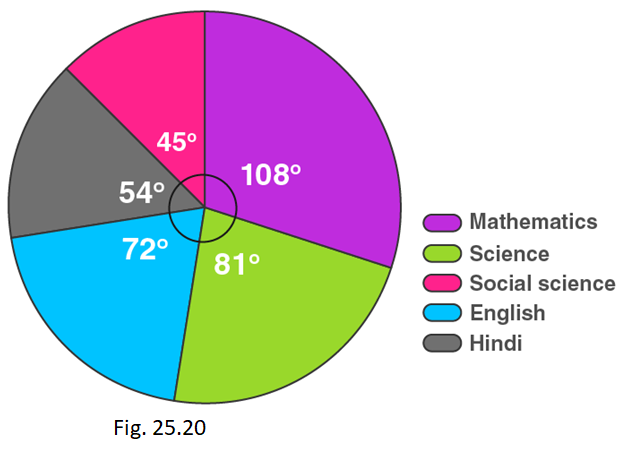
Solution:
Marks secured in mathematics = (central angle of maths × Total score secured) / 360°
= (108 × 440) / 360o = 132 marks
Marks secured in science = (central angle of science × Total score secured) / 360°
= (81 × 440) / 360o = 99 marks
Marks secured in English = (central angle of English × Total score secured) / 360°
= (72 × 440) / 360o = 88 marks
Marks secured in Hindi = (central angle of Hindi × Total score secured) / 360°
= (54 × 440) / 360o = 66 marks
Marks secured in social science = (central angle of social science × Total score secured) / 360°
= (45 × 440) / 360o = 55 marks
| Subject | Mathematics | Science | English | Hindi | Social Science |
| Marks secured | 132 | 99 | 88 | 66 | 55 |
5. In Fig. 25.21, the pie chart shows the marks obtained by a student in various subjects. If the student scored 135 marks in mathematics, find the total marks in all the subjects. Also, find his score in individual subjects.

Solution:
Let us calculate the total marks.
So,
Marks scored in mathematics = (central angle of maths × Total marks) / 360°
135 = (90 × Total marks) / 360o
Total marks = (135 × 360)/90
= 540 marks
Now,
Marks scored in Hindi = (central angle of Hindi × Total marks) / 360°
= (60 × 540) / 360o
= 90 marks
Marks scored in Science = (central angle of Science × Total marks) / 360°
= (76 × 540) / 360o
= 114 marks
Marks scored in Social science = (central angle of Social science × Total marks) / 360°
= (72 × 540) / 360o
= 108 marks
Marks scored in English = (central angle of English × Total marks) / 360°
= (62 × 540) / 360o
= 93 marks
| Subject | Mathematics | Science | Social science | English | Hindi |
| Marks secured | 135 | 114 | 108 | 93 | 90 |
6. The following pie chart shows the monthly expenditure of Shikha on various items. If she spends Rs 16000 per month, answer the following questions:
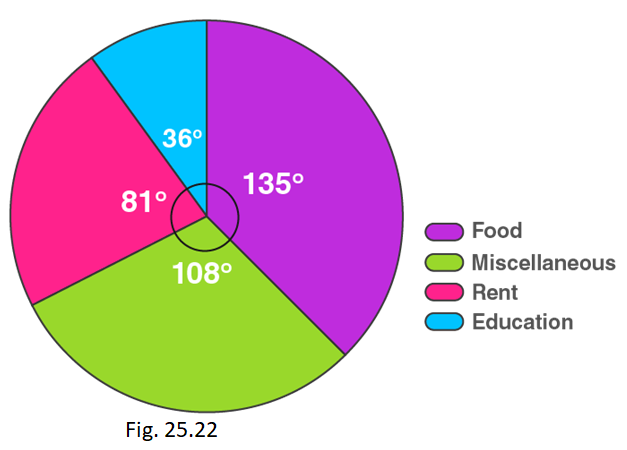
(i) How much does she spend on rent?
(ii) How much does she spend on education?
(iii) What is the ratio of expenses on food and rent?
Solution:
(i) Money spent on rent = (central angle of rent × Total money spent) / 360°
= (81 × 16000) / 360o
= Rs 3600
(ii) Money spent on education = (central angle of education × Total money spent) / 360°
= (36 × 16000) / 360o
= Rs 1600
(iii) Money spent on food = (central angle of food × Total money spent) / 360°
= (135 × 16000) / 360o
= Rs 6000
Ratio of expenses on food and rent is Rs 6000/Rs3600 = 5/3
Ratio = 5:3
7. The pie chart (as shown in the figure 25.23) represents the amount spent on different sports by a sports club in a year. If the total money spent by the club on sports is Rs 108000, find the amount spent on each sport.

Solution:
Money spent on cricket = (central angle of cricket × Total money spent) / 360°
= (150 × 108000) / 360o
= Rs 45000
Money spent on football = (central angle of football × Total money spent) / 360°
= (60 × 108000) / 360o
= Rs 18000
Money spent on tennis = (central angle of tennis × Total money spent) / 360°
= (50 × 108000) / 360o
= Rs 15000
Money spent on hockey = (central angle of cricket × Total money spent) / 360°
= (100 × 108000) / 360o
= Rs 30000
